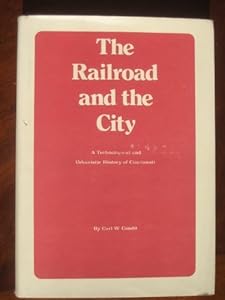 So, I've decided to go into the realm of the really esoteric this week and talk about a book that I read
So, I've decided to go into the realm of the really esoteric this week and talk about a book that I read because of my ongoing interpretation of Cincinnati railroad history at a museum whose name must be shrouded in the cloak of ambiguity. To be perfectly honest I expect that exactly none of my readers will ever in their lives have any desire to pick up this book. It is, as you can probably imagine, an incredibly technical and detailed history regarding the history of railroads, as well as other means of transportation, within Cincinnati. Condit succeeds in that he provides a very narrow and detailed exploration of a subject which there was no previous coverage and forty years later there still is very little additional coverage. Essential for Cincinnati railfans and rail researchers, but that's pretty much the only audience.
To be completely fair as a reviewer, this book gets a lot of bonuses because it's the only book in its particular field and remains, to my knowledge, the only general reference text on Cincinnati railroads. Condit carefully tracks the ascendancy of rail transportation, especially after the Civil War, and the continued growth and development within Cincinnati. Condit even goes through the growth and development of the Little Miami, Cincinnati, Hamilton, & Dayton, and the still operating Cincinnati, New Orleans, & Texas Pacific Railroads, as well as numerous other local lines that eventually merged with some of the largest railroads in the United States. Condit also does a good job about explaining the growth of streetcars as well as electric interurban transit and how with traditional steam railroads they together created a three-tiered system of passenger transit across various distances, eventually leading to the abandonment by steam railroads of local accommodation trains and the transfer, almost exclusively, to long-distance Pullman sleeper trains.
In conjunction with the growth and gradual changes in rail service, Condit takes us through the growth of terminal facilities in Cincinnati and the gradual shortcomings of such facilities as traffic grew and became increasingly more complex. Despite repeated attempts to create a central terminal for all railroads serving Cincinnati it wasn't until the late 1920's that a plan was agreed upon and construction of a terminal facility was begun, which opened as Cincinnati Union Terminal in 1933. Perhaps what I found most interesting was the fact that none of the five stations that served Cincinnati before CUT all had hand-thrown switches which were considered outdated by the 1900's. I also found it rather hilarious that the Fourth Street Station was just a house the C&O Railroad had bought and laid some tracks outside of.
Probably the thing that most stands out about this text, though, is its bitter vehemence at the decline of rail transportation in all its forms and the destruction of much rail infrastructure because of this decline. The last few paragraphs of this book are very vocal against the growing reliance upon automotive transportation and the growing system of interstate highways being constructed across the United States. Granted, I can quite understand the author's frustrations as he was writing in the 1970's and for a while demolition of Cincinnati's historic art deco Union Terminal was seriously considered. Fortunately for the people of Cincinnati a new purpose was eventually foun for the Union Terminal and it continues to remain an important part of Cincinnati's cultural heritage. Or something. I don't know, I like trains.
- Kalpar

No comments:
Post a Comment